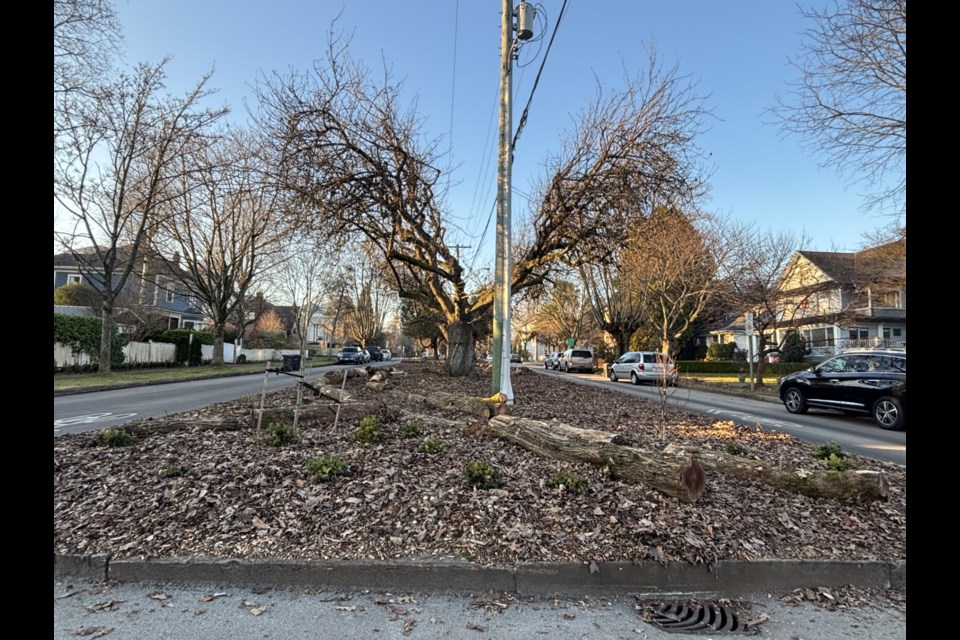Things are getting a little wild in the Queen’s Park neighbourhood.
The City of New Westminster has started implementing its biodiversity and natural areas strategy on a Fifth Street boulevard. Recently, city crews removed grass and started planting native plants and placing large logs.
“Crews are currently focused on completing the naturalization work on Fifth Street between Third and Fourth avenues,” said Erika Mashig, deputy director of parks, policy and planning. “After this initial phase, which is still in progress, we will evaluate the project's success, in collaboration with residents. This evaluation (after about a year) will help us determine if and how we might extend the naturalization efforts further up Fifth Street.”
Mashig said the large logs that have been placed on the boulevard will be removed and reused at another location. She said the remaining work to complete the planting will be completed in the spring.
Adopted in 2022, the biodiversity and natural areas strategy includes actions to protect species and enhance the quality of natural areas in the city. The Fifth Street median is one of the areas that’s been identified as a location for naturalization.
Questioned about the work at the Jan. 27 council meeting, Mashig explained that these types of wide, grassy boulevards require weekly mowing for many months of the year.
“The idea is to reduce carbon emissions, reduce maintenance on those medians, but also convert them to provide wildlife and pollinator habitat,” she said. “So there has been some implementation that has started.”
Mashig said more flowering shrubs and other pollinator species will be added in the spring.
“There are a lot of leaves and debris that are lightly scattered to kind of start to turn the soil over, return nutrients to the soil after the grass was removed,” she told city council. “There are some native plants that have been planted, but there are more to come.”
Creating naturalized areas and pollinator meadows in the city’s urban parks and open spaces is an important part of New Westminster’s biodiversity strategy to increase resiliency and biodiversity, Mashig said.
“These diverse plantings of native plants, wildflowers, and grasses provide crucial food, shelter, and nesting habitat for pollinators like bees, butterflies, and birds,” she said in an email to the Record. “Beyond improving biodiversity, these areas help the soil retain moisture (beneficial for trees during droughts), reduce ground temperatures (helping to keep our community cooler), and create beautiful, natural spaces for everyone to enjoy.”
Mashig said the vision, specifically for the Fifth Street median, is to create a more formal trail through the planted area and meadows, inviting people to explore and appreciate urban habitat.
“We are excited to see the initial implementation in this small area develop over the next year and look forward to hearing from the community,” she said.
A sign erected at the south end of the boulevard discusses native shrub identification — but more signage is coming.
“We will be installing a temporary sign on Fifth Street, before we continue with planting between Third and Fourth avenues, describing the naturalization project and its benefits,” Mashig said. “We have installed signage at select locations across the city within naturalized areas to help inform the public about the importance of these urban habitats. The existing sign focusing on native shrub identification will remain.”
Why Fifth Street?
Mashig recently told council the Fifth and Second streets medians were selected for naturalization because they are extra wide and have large areas of green lawn that need to be maintained. She later told the Record the city does not currently have plans to naturalize the boulevard on Second Street.
“They certainly can provide wildlife benefit because they are close to Queen's Park, which is identified as a hub in the biodiversity strategy. So, a large, forested area where we have lots of birds, insects, pollinators habitating, and then they can use these linear corridors or connections to move around the city. They're a food source and they're also habitat,” she said. “That's the rationale within the biodiversity strategy.”
Because the city has no immediate plans to expand the naturalized area on Fifth or Second street boulevards, Mashig told the Record a comprehensive cost estimate for naturalizing these areas has not been developed.
Community concerns
At the Jan. 27 council meeting, Coun. Daniel Fontaine said he had heard from a number of people who have concerns about this project. He said residents would appreciate being informed by the city when further work is taking place on the boulevards as part of this initiative.
“They did convey to me that they would have appreciated having a bit of a heads-up,” he said. “Not all of them are opposed to it, but they just would have appreciated having a bit more heads-up. So, I'm pleased to hear that that process will be in place moving forward.”
Mashig said signs were provided on the median about the initiative, but the city will increase communication about future works connected to this project.
“Staff have acknowledged that moving forward, they will notify residents directly with a letter and provide an opportunity to provide some feedback before they commence with that work,” she told council. “So, better notification, better communication on staff's part.”
In April 2022, New Westminster city council approved the 118-page biodiversity and natural areas strategy. One of the strategy’s goals is to increase the amount and quality of habitat across the city to improve biodiversity and human well-being.





